Surfski First Looks: The Carbonology Switch
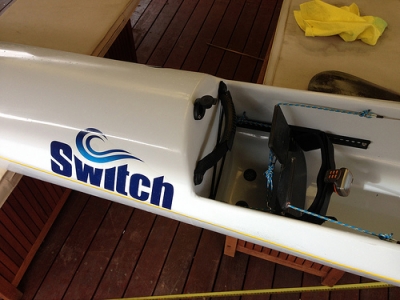 The Switch
Credits: Brett McDonald
The Switch
Credits: Brett McDonald
A little while ago I was asked if I would like to demo a new ski in development, sounded fun, so a few weeks ago I got the call to pick up the first of two skis I would test over the next few weeks: The Switch
The “Switch” is the brainchild of the designers that brought us the Carbonology Atom. Although the Carbonology Atom has been well recognised as a very fast ski, it really only carved out a niche market with very skilled paddlers.
Rob Welsh and Gary Butlion have been back to the drawing board and with the assistance of a silent partner and what they have learnt from the Atom, they set about designing a ski that would retain the shorter length, low volume and good speed, but make it more accessible to us mere mortal paddlers.
While not being any expert on hull design the immediate differnces to me were the reduced rocker and the increase in stern volume in the new design.
The group took the “switch” plug to Carbonology and had the owner, Hein, build a handful of skis for testing. Being very proud of his work, Hein stickered the skis with his Carbonology branding, but at the time of writing this review the owners of the “Switch” are yet to decide who the builder of this ski will be. [Editor: I've since confirmed that the ski is most definitely a "Carbonology" boat!]
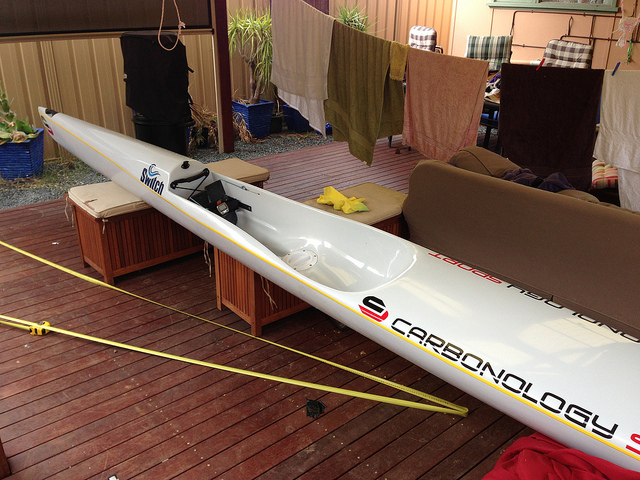
Prototype or Pre-Production? Carbonology-buit Switch
Why the “Switch”?
The short answer….. is that it is a ski that can “switch” from underslung rudder to a trailing rudder.
The longer answer…..
Four years ago when the Atom was first designed, I was contacted as a then adventure racer to see if I was interested in paddling a new short ski that would be built for multisport racers. But after ascertaining it was an elite level ski I politely declined the opportunity given I only had 2 days a week to train in my then V10L. With all the other training adventure racers do I just couldn’t afford to be trying out a new ski in the training time I had.
History tells us that the Carbonology Atom went on to be one of, if not, the fastest flat water ski on the market…but with a stability level that only die-hard paddlers could master.


A look at the hull shape
Adventure and multisport racers have to divide their time between swimming, running, riding and paddling. Given that they often climb into their ski after having done one of those activities prior they need to have craft that even when fatigued they can perform in. Adventure racing is also about point to point racing, so a ski that copes with wind, swell and chop from all directions is the order of the day. Adventure racers also find themselves racing in rivers, estuaries and lakes where a trailing rudder is sometimes needed.
I guess you’ve figured out by now that this is no ordinary “Ocean Ski”, in my opinion it is by design, a crossover between an ocean ski and a downriver racing K1.
Layups
I have had two skis to paddle.
The first ski I was given was a “Ocean” Carbon Lay-up weighing in at a smidge under 11kg. This ski was built to test it’s ocean capability and was fitted with dual bullet scuppers.
The second “Multisport” ski was laid up using a carbon & kevlar woven cloth, comes in at 14kg and had the river plastic tube scupper fitted.
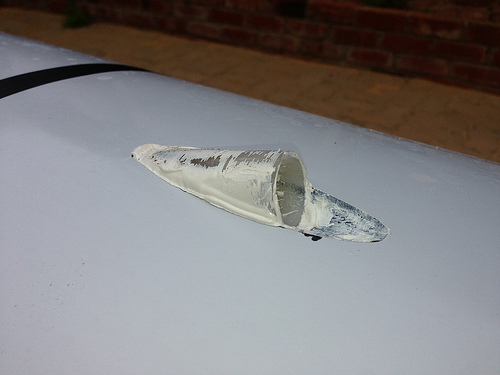
Tube scupper for river use
Finish
The gel coats on both skis are a grey colour that appears like a matt finish and I reckon it looks great. It gives the skis a utilitarian look, something adventure racers often like.
Bucket drainage
Both skis had an inspection/access port reset into the bucket hump. The port allows the fitting and replacement of the river scupper plastic tubing option. It could also be a handy place to store items like your keys, phone, etc.
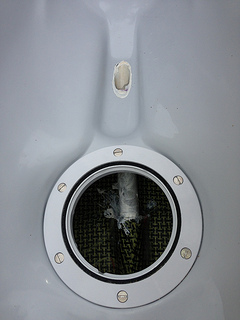
This multsport layup ski had the downriver scupper which consists of some plastic tubing run from the footwell through the hull to under the seat, held in place and sealed with silicone sealant. The benefit of this plastic tube is that it can run over rocks and logs in a river and not sustain damage. When it wears out it can be removed and replaced with some more inexpensive tubing.
The Carbon Ocean ski had the two bullet scupper. I know they are not meant to induce too much drag due to the bullet design but they drain so well I have to question whether one would be enough?
The river scupper option with the plastic tube is functional but not outstanding. There was a constant 1 -2 inches of water around my heels at any speed below about 11km/hr and is much slower to drain.
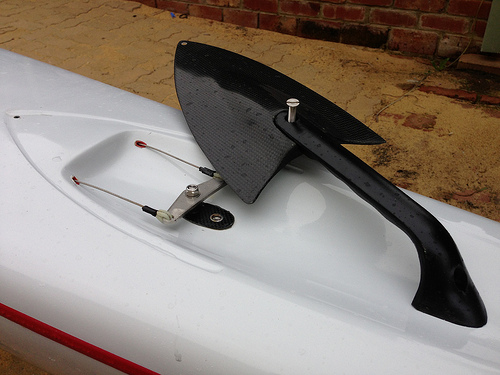
Neat design for the rear handle and tiller cover
Seat and Bucket
While ski seats tend to be a lottery depending on the shape of your rear end, for me I found the seat in the ski the most comfortable I have used. This comes as no surprise as someone who finds the all Carbonology buckets comfortable.
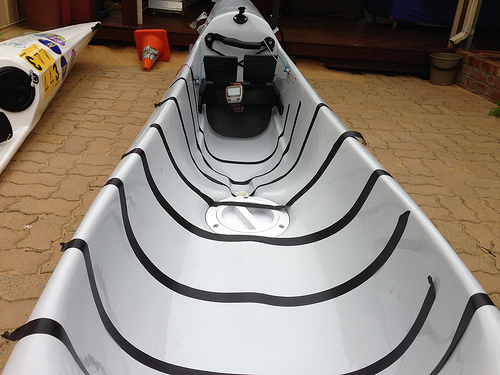
Comfortable bucket
The hump is very low in this ski. Great news for those with short legs and it allows for excellent leg drive. There is a drawback with this though. I discovered this on a cold winters morning when paddling the ski with the river scupper, the footwell fills with water as you get in, then as you start paddling that frigid water sloshes up into the seat, brrrrr. I guess a cork or plug could be used to prevent this. My usual ski has the snorkel valves fitted and I am accustomed to having a dry footwell in these cold conditions.
I am 6ft 3in tall and I fit in the bucket without any effort. The footplate had a few more inches of adjustment left and with my size 12 feet (UK 47) I could fit my feet with minimalist shoes into the footwell without an issues.
The bucket is shaped so that you are very snug in it. I find this an advantage stability wise as you have a larger area of contact should you need it to stabilise yourself without restricting rotation and leg drive. It also reduces the amount of water it can hold when water splashes over the sides or bow.
The footplate used was the standard carbonology footplate which is very easy to adjust without the need for any tools. You just pull out two spring loaded lugs, adjust the length and release the lugs, an operation taking a few seconds.
Trailing rudder
The Multisport layup ski I paddled had a second set of rudder tubes fitted with the stainless cables ready to go. Rather than dictate which trailing rudder should be fitted, at this point in time the idea is to supply the ski ready, but not fitted with a trailing rudder to allow the customer to decide which rudder fits their needs.
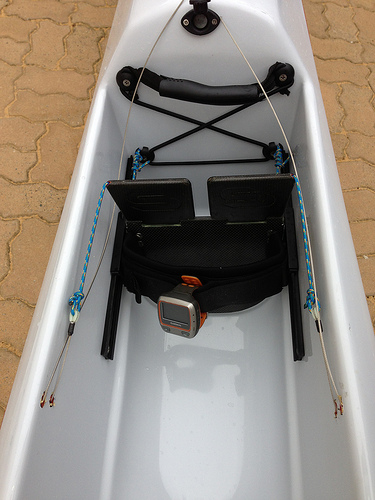
Two sets of rudder lines
Paddling the Switch
(Brett came over all shy about his voice-over so masked it with music!)
Upwind
The ski is very stable upwind and its low volume bow allows it to maintain momentum as it goes through small waves, however, it’s low volume also makes it a wet ride with quite a bit of water making it into the bucket in anything over a 1-2 foot chop. The ski with the dual bullet scuppers drains this water almost instantly but the plastic tube scupper struggled to empty the water before it was topped up in the stormy conditions I paddled the ski in. While not ideal, the speed of the ski was not too badly effected due to the low volume of the footwell.
Cross wind and at angles.
As a ski that is aimed at adventure racers I have tested it extensively in cross winds and chop between 1 -3 feet. It is the fastest stable ski I have paddled in these conditions, it really is well suited to point to point racing allowing you to keep the power on without having those “moments” some skis can throw in. The low volume and profile bow does not allow the wind to push the ski around as you crest waves.
Downwind
The ski is fun to paddle downwind, picking up runs very easily, but…it’s low volume bow will spend a great deal of time underwater if you are not picking a direction to travel and working across the runs. The skis short length allows it to make the most of short wind driven runners which are found on protected water like harbours and lakes. I have not done any big downwind conditions (over 2 metres) so I can’t comment on its ability here)
Stability
The question most people ask when seeing a new ski, is will I be able to paddle it? As someone who paddles elite level skis I guess I am not really qualified to answer that for anyone. All I can report is that I find it more stable than other elite level skis I have paddled and it is nothing like the Atom it shares some heritage with. I feel it would be within the ability of the intermediate to elite level adventure racer who can only find 2 – 3 paddling sessions a week.
But is it fast?
Before paddling the ski, I did an 8km warm up paddle in my own (12kg) ski on flat water to get an idea on what speed I could do in the current conditions at various heart rates.
When I jumped in the Carbon (11kg) Switch, I was immediately surprised by the skis stability for it’s size and volume. When underway I saw that it was indeed faster than my own ski over the same body of water for some given heart rates. I did a standing start in it and saw a .5km/hr higher top speed! So the difference in speeds at both my cruising and race pace was enough to impress me.
After a week and 90km in the 11kg Carbon ski I changed to the 14kg Carbon/Kevlar ski. I paddled this heavier ski in a lot of stormy weather and only in the past few days did I find some calm conditions to test it’s speed. While it retained good cruising and race pace I felt it was on par with my current ski. For this weight of ski, on flat water, with the plastic hose scupper option, that is impressive.
Surf
While I don’t generally test other peoples skis in surf, the winter storms we have had in Perth have been generating a lot of swell. I couldn’t help but spend time in the ski on a favourite break that doesn’t close out so it’s a safe break for skis. This ski just loves the waves. Not sure why that is, whether it’s the length combined with the hull shape but I had an absolute ball spending hours riding wave after wave over a few sessions. The ski is happy sitting right up “in” the wave or carving along the face without being pushed sideways. The rudder sent with the ski is quite big, so would help in the surf.
Conclusion
In summary I think the designers should be happy with their design. I think it is a good mix of stability and speed, low volume and versatility which will appeal to the adventure racing market. As a paddler who understands adventure racers, I would recommend you check this ski out if you know there is one in your area. Time will tell if paddlers see it as a downwind weapon, but that is a review for someone else to write.

